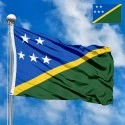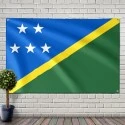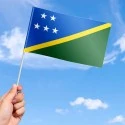The flag of the Solomon Islands is a vibrant and modern symbol that encapsulates the nation’s geography, natural resources, and its journey to independence. Adopted on November 18, 1977, in anticipation of its full sovereignty, the flag is a visual representation of the country’s identity and aspirations.
Design and Symbolism
The flag is divided diagonally from the lower hoist-side to the upper fly-side by a narrow yellow stripe. The upper triangle is dark blue, and the lower triangle is bright green. In the upper blue section, near the hoist, are five white five-pointed stars arranged in two rows.
-
Blue: The dark blue triangle represents the Pacific Ocean, which surrounds the islands and is the source of much of the nation's life and resources. It symbolizes the sea’s importance for fishing, trade, and as a cultural lifeline.
-
Green: The green triangle symbolizes the lush and fertile land of the Solomon Islands. It represents the country's rich agricultural resources, forests, and the natural beauty of the islands.
-
Yellow: The bright yellow diagonal stripe represents the golden sun, which is a source of light and life for the islands. It also symbolizes the unity and prosperity of the nation.
-
The Five Stars: The five white stars originally represented the five major districts of the islands at the time of the flag's design. Today, they are seen as symbols of the five main island groups: Choiseul, Western Province, Isabel, Malaita, and Makira-Ulawa. The white color signifies purity and peace.
History and Adoption
Before achieving independence from the United Kingdom, the Solomon Islands used a British Blue Ensign with a circular emblem featuring a crowned lion and an earlier coat of arms. As the country prepared for self-governance, a national competition was held to design a new flag. The winning design was created by Mr. John Kilibwa, a young teacher who was one of the many entrants in the contest.
His design was chosen for its simple yet powerful symbolism, which was distinct from the colonial flag. The flag was officially adopted on November 18, 1977, and was first hoisted on July 7, 1978, when the Solomon Islands officially gained independence. The flag's diagonal design was a unique feature that set it apart from most other national flags, capturing the dynamic and forward-looking spirit of the new nation.
Flag Size and Proportions
The official proportions of the Solomon Islands flag are 1:2 (width to length). The yellow stripe runs diagonally across the flag, separating the blue and green triangles. The placement and size of the five stars in the upper canton are also strictly defined to maintain the flag's official appearance.
The Country, Region, and Meaning for Residents
The Solomon Islands is a sovereign country consisting of a double chain of over 990 islands and atolls in Oceania, situated in the Melanesian region. Its geography is dominated by volcanic islands, lush rainforests, and a rich marine environment. The population is predominantly Melanesian, with a strong connection to the land and sea.
For the people of the Solomon Islands, the flag is a profound symbol of their national identity. The colors represent their daily life and the resources that sustain them: the ocean for fishing and the land for farming. The stars symbolize the unity of their diverse islands, reminding them that despite their geographical separation, they are one nation. The flag is a source of national pride, representing their sovereignty, their unique culture, and their shared aspirations for a peaceful and prosperous future.
Interesting Facts
-
The flag's design was a result of a national contest, which saw numerous submissions from citizens across the islands.
-
The flag's five stars originally corresponded to the five administrative districts of the country at the time, which were Malaita, Central, Eastern, Western, and Makira. Over time, the interpretation has shifted to represent the main island groups.
-
The flag's vibrant colors are often seen as reflecting the natural beauty and sunny climate of the islands, making it a source of joy and pride for its citizens.
The flag of the Solomon Islands is a powerful testament to the nation’s history and its future. It beautifully captures the essence of a proud, independent, and united people whose lives are inextricably linked to the land and the sea.
In the demonstration images, full-size flags are shown with proportions of 2:3, and hand-held flags with proportions of 1:2.







 Waving flag
Waving flag
 Sizes:
Sizes:
 Round flag
Round flag
 Sizes:
Sizes:
 Rectangular flag 2:3
Rectangular flag 2:3
 Sizes:
Sizes: